Insignia of the 752nd Tank Battalion
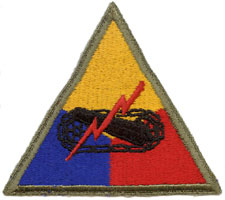
Armored Forces
Insignia (Plain)
752nd tankers wore the plain armored forces insignia
during the war years. The equilateral triangle is divided into yellow,
blue, and red sections to represent the three branches from which the
armored forces were formed. The tank tread, gun, and lightning flash
symbolize mobility, power, and speed. The patch measures 4 inches
across the base and 3 inches high. Only 8 independent tank battalions
were initially authorized to display their unit number on the insignia
(70th, 191st, 741st, 742nd, 743rd, 744th, 746th and 751st). From the webmaster's collection.
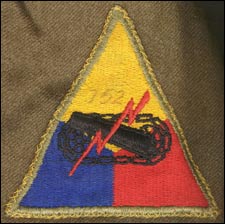
752nd Insignia
(Hand-Written)
The men of the remaining independent tank battalions became unhappy
that they were not authorized to display their unit number. Though
against regulations, the men of the 752nd began to display their
battalion numbers on their patches in a variety of ways. The owner of
this patch, Sgt. Ray Holt of B Company, expressed his pride in the
outfit by writing the numbers "752" in pencil on his dress uniform's
standard armored insignia. The writing on this patch is known to
pre-date the end of the war. From the webmaster's collection.
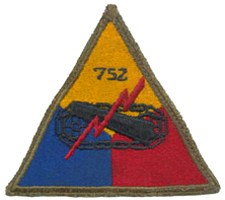
752nd Insignia
(Hand-Stitched)
The 752nd tankers quickly became bolder in displaying their battalion
identification. The owner of this patch had very carefully
hand-stitched the numbers "752" in black thread. Such infractions by
combat vets were seldom enforced in-theater. It is believed that this
patch was hand-sewn during the combat period. From the webmaster's collection.
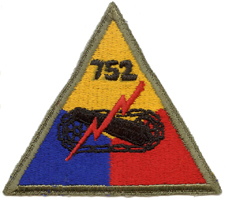
752nd Insignia
(Machine-Embroidered)
Toward the end of the war, the regulations were finally changed to
allow all independent tankers to display their battalion numbers. Soon,
a variety of machine-embroidered patches such as the one shown here
became available. There is no evidence to date of a machine-embroidered
patch being worn in the 752nd prior to the end of the war, but they
became very popular shortly after the war ended. The patch shown here
is believed to have been produced in 1945. From the webmaster's collection.
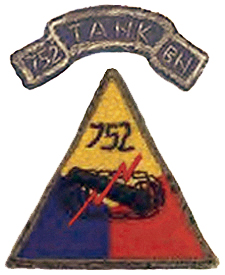
752nd Gold
Bullion Scroll (Navy Blue)
After the war ended, a few enterprising manufacturers in Italy began to
add items of interest in the insignia they produced. The gold bullion
embroidered unit scroll was very popular, but hard to find today. Shown
here is a bullion scroll worn over an armored forces patch with
hand-stitched numbers. This is highly unusual, because the scroll was normally worn above a plain armored forces patch as shown in photos below.
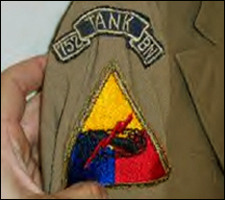
752nd Gold
Bullion Scroll (Navy Blue)
Note that this
particular bullion scroll was worn above a plain armored patch without
battalion numbers, which is typical of the plain patches that were normally worn with the 752nd scroll. Note the subtle difference in
lettering styles between the bullion scrolls on this page. The right shoulder position on the uniform indicates that the 752nd was this vet's former unit.
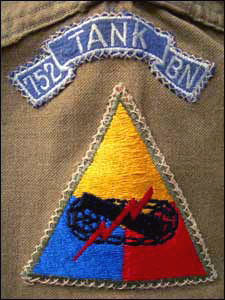
752nd Blue
& White Scroll
This somewhat less decorative scroll is the one that was most commonly
worn in the postwar period, and is therefore the style of 752nd
scroll that is easiest to find today. This scroll had simple white
letters and numbers embroidered on a blue background. Blue was now
becoming a more symbolic color in the 752nd, likely due to the azure
background of the distinctive insignia (DI) that was also coming into
vogue (see below). Note the fancy cross-stitching on both the scroll
and the armored forces insignia. This stitching was quite popular with
752nd postwar tankers as a way of individualizing their uniforms. From the webmaster's collection.
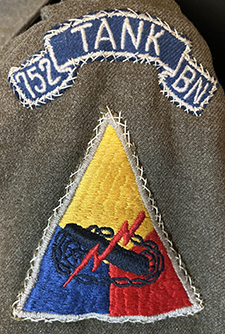
752nd Blue
& White Scroll Over Narrow Theater-Made Patch
Another example of the most commonly worn 752nd scroll, paired with a narrow theater-made plain tanker's patch. The patch inverts the standard triangle dimensions, and measures 3½ inches tall by 3¼ inches wide. Note the extremely light khaki border. This Ike jacket belonged to a T/5 who initially served as a medic and then became a medium tank crewman. He was in the 752nd from December 1945 to February 1947. This soldier was promoted to T/5 in January 1947, so this uniform dates to sometime between January 1947 and his Army discharge in April 1947. From the webmaster's collection.
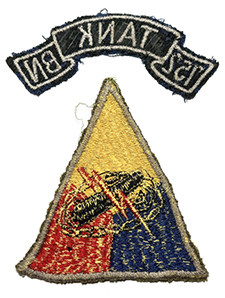
752nd Scroll and Narrow Theater-Made Patch, Reverse Side
A spare patch and 752nd scroll tab were tucked inside the pocket of the above T/5's uniform. This is the same type of narrow patch depicted above, measuring just 3¼ inches at the base and 3½ inches tall. What's perhaps more interesting about this patch is that the return threads on the reverse side are yellow, rather than the usual white, drab, or black. The scroll is the same shade of blue as the one on the uniform above, but the backing material is a dark charcoal gray so from the reverse side it appears almost black. From the webmaster's collection.
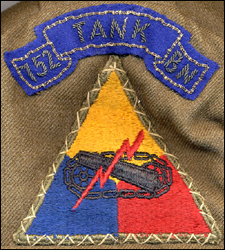
752nd Blue,
Silver, & Gold Bullion Scroll
Another
version of the blue scroll, featuring what are now tarnished silver
letters and a tarnished gold bullion border. Similar to the scroll
shown above, the blue background relates to the azure heraldic color of
the official 752nd DI. The silver lettering is in keeping with the
752nd's second heraldic color, officially known as argent. Again, note
the decorative cross-stitching on the edges of the armored forces
insignia. From Dave Kaufman's collection, with permission.
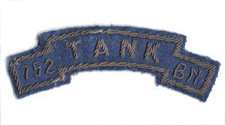
752nd Silver
Bullion Scroll
A
very rare theater-made 752nd scroll. The bullion is tarnished silver,
sewn onto blue wool with a tan cloth backing. Note the squared edges.
Measures 3¾" long and 1⅜" high.
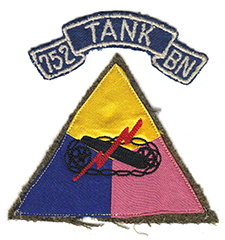
752nd Scroll With German-Made Satin Patch
A fairly typical 752nd scroll that was worn with a beautiful postwar German-made satin tanker's patch on a wool base. Note the pale colored red field. Identification is per Kurt Keller's excellent reference book on armored, tank destroyer, and cavalry patches titled "Emblems of Honor" (Page 22). From the webmaster's collection.
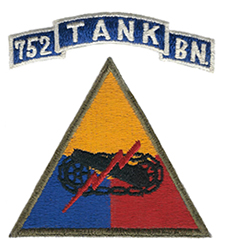
752nd Japanese-Made Scroll Yellow
A highly unusual Japanese-made tab over a plain tanker's patch. Note the squared edges of the tab, and the bold, angular letters. While it seems highly unusual for a Japanese maker to produce these scrolls, the origin and authenticity of the tab have been professionally validated. From Dave Kaufman's collection, with permission.
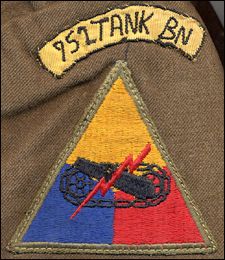
752nd Yellow
& Black Handmade Scroll
A "crude and unusual" 752nd Tank Battalion scroll in yellow and black.
Black lettering hand-stitched on yellow corduroy. It was once believed that this scroll was unique to the 752nd's Recon
Platoon, since recon units often adapted the yellow and black colors
that were favored by the Cavalry. However, in 2023 the owner kindly provided the webmaster with the laundry number and jacket size. The uniform traced to an Armorer (MOS 511) who served in HQ and D Company. He was never in the Recon Platoon. From Dave Kaufman's collection, with permission.
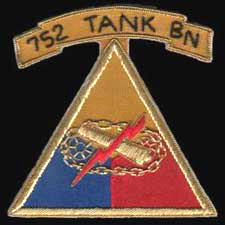
752nd Gold
Bullion Collector's Patch
This exquisite-looking 752nd gold bullion patch with scroll is
beautiful to look at, but it could never have been worn by a 752nd
tanker. Fancy gold bullion patches such as these were produced well
after the war ended, and well after the 752nd had been deactivated.
This rubber-backed patch was originally sold as part of a series of
similar armored bullion patches which were marketed strictly as
commemorative collector items. From the webmaster's collection.
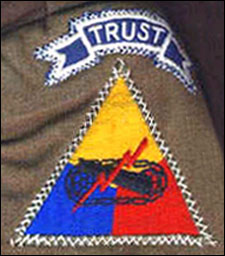
TRUST 15th
Tank Company Scroll
A very rare scroll from the TRUST (TRieste US
Troops)
15th Tank Company, which performed peacekeeping duties on the
Italy-Yugoslavia border after the war. The design of the scroll
reflects the heritage of the 752nd Tank Battalion, since the TRUST Tank
Company was formed from elements of the 752nd in 1947. The 15th Tank
Company was redesignated as Tank Company, 351st Infantry Regiment in
December 1949, and continued its peacekeeping mission in the Trieste
area until 1954. Tank Company/351 was inactivated in the States in 1955.
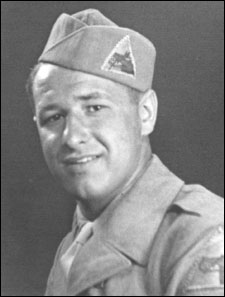
Garrison Cap
Insignia
A studio photo of an unidentified 752nd B Company tanker, showing both
the standard armored shoulder patch and a slightly smaller version sewn
onto the garrison cap. The insignia in this photo almost certainly
pre-dates November 1945, since the photo was sourced from a 752nd
combat vet who left Italy in the middle of that month. Only one other
photo of a 752nd tanker with a garrison cap insignia has been found to
date, and it was sourced from the same vet as the photo shown here.
Scroll down further on this page for a description and color photo of
the standard armored garrison cap. From the webmaster's collection.
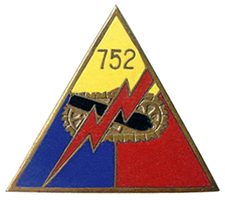
752nd Tanker's Triangle Enameled Insignia
The standard tanker's triangle enameled pin with the numerals "752" began appearing late in the postwar period. These were not authorized DUI's, but were used more for decorative purposes. When sold with a pin fastener, it was sometimes worn on the garrison cap. More commonly, it was manufactured without the pin and glued directly to various souvenir items, such as belt buckles, cigarette lighters, and ash trays. One surviving 752nd ash tray from Cormons, Italy uses three of these enameled insignia -- a standard size glued to a .50 machine gun bullet, and two mini-sized insignia glued to each side of the vet's name plate on the ash tray base. From Dave Kaufman's collection, with permission.
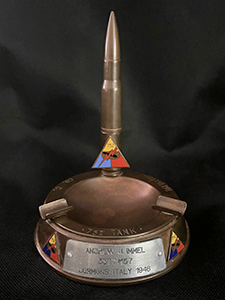
752nd Souvenir Ash Tray/Lighter With Enameled Triangles
The 752nd enameled triangle appeared on a number of souvenir items that were sold in the local shops near the 752nd's postwar facility in Cormons, Italy. This 752nd ash tray and lighter is a good example, and is engraved 1946. Three enameled tanker's triangles are attached. The insignia on the .50 bullet is substantially larger than the two on the tray, and it also has a much lighter blue field. The .50 caliber round contains a cigarette lighter, which can be accessed by lifting off the top half of the round. This same design was also used for 88th Infantry units, as well as for crews of Navy ships that visited nearby Trieste Harbor. From the webmaster's collection.
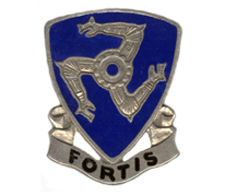
752nd Tank
Battalion Distinctive Unit Insignia (DUI) (Postwar, US-Made, Dondero)
The 752nd, like all other units, had its own Distinctive Unit Insignia (also
called a DUI). A DI was a decorative emblematic pinintended to build esprit de
corps. The official colors of the 752 DI are azure blue and argent. Three spiked
arms and fists symbolizing striking power emerge from a spur gear symbolizing
mechanization. The word Fortis is Latin for Powerful. The 752nd DI was authorized in 1942, but did not come into use until
1946, well after the war ended. Only one photo of a 752nd tanker wearing a DUI has surfaced to date, and that was an officer's studio portrait photo taken in December 1946 in
Italy. It shows the DI depicted here with the pointed bottom and open scroll. The 752nd Tank Battalion DI shown to the left was produced by Dondero in
Washington DC, and is cataloged as #752A1 by the American Society of Military Insignia Collectors (ASMIC). From the webmaster's collection.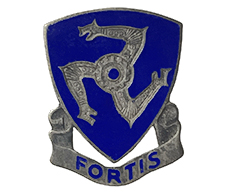
752nd Tank
Battalion Distinctive Unit Insignia (DUI) (Postwar, Italian-Made, No Hallmark)
Several Italian shops produced 752nd DUIs for sale to the tankers in 1946-1947 during the latter postwar period. These were faithful to the original US-produced Dondero DUI, but incorporated a European Vertical Safety Pin-Back (EVSPB) fastener. Some but not all Italian makers displayed the "Fortis" motto in azure blue letters, as shown here. This Italian-made 752nd DUI was purchased in Italy and bears no manufacturer's hallmark. This design is cataloged as #752A2 by the American Society of Military Insignia Collectors (ASMIC). From the webmaster's collection.
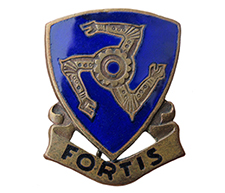
752nd Tank
Battalion Distinctive Unit Insignia (DUI) (Postwar, Italian-Made, Alberti)
This Italian-made 752nd DUI was made by Alberti of Milan. The overal design is the same as the one above, but it was produced in a bronze finish rather than the authorized argent (silver) color. The clasp is a manufacturer-specific style of European Vertical Safety Pin-Back (EVSPB), with the maker's name "Alberti & Co Milano" stamped on the fastener's base. The motto is done in black rather than the blue letters on the Italian-made DUI shown above. This Italian-made 752nd DUI was purchased in Italy and bears no manufacturer's hallmark. This design is cataloged as #752A3 by the American Society of Military Insignia Collectors (ASMIC). This DUI and the ASMIC example are both by Alberti, but the one shown to the left has a black motto unlike the ASMIC sample.
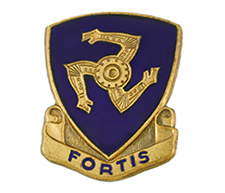
752nd Tank
Battalion Distinctive Unit Insignia (DUI) (Postwar, Italian-Made, No Hallmark)
This Italian-made gold-colored 752nd DUI bears no hallmark and is not cataloged by the American Society of Military Insignia Collectors (ASMIC). The gold defies the heraldry of the design, which officially calls for azure blue and argent (silver). The clasp is a European Vertical Safety Pin-Back (EVSPB) with no maker's mark. There are several important differences between this DUI and the other known designs. The most obvious difference is the closed, grooved area inside the scroll at the bottom of the DUI, instead of an open space in the other designs. The shield is less tapered, giving this DUI a more squat appearance. The three arms are positioned further from the edges of the blue field. The motto appears in blue letters, as is typical of several Italian makers. One other deviation versus all other known designs is the absence of blue in the center of the spur gear.
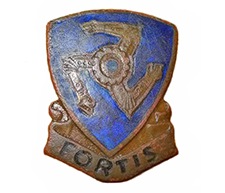
752nd Tank
Battalion Distinctive Unit Insignia (DUI) (Postwar, No Hallmark, Dug)
This is yet a different closed-scroll 752nd DUI that is not cataloged by ASMIC. This particular DUI was dug out of the ground in Italy several years ago, and the image depicts its cleaned but badly worn condition. The area above the scroll is closed as in the uncataloged DUI depicted above, but the area does not appear to be grooved. The shield appears to be more tapered and the arms are positioned closer to the edge of the blue field, similar to the cataloged DUI types. Note that unlike the other closed-scroll DUI, this one features a black motto and has blue coloring in the center of the spur gear.
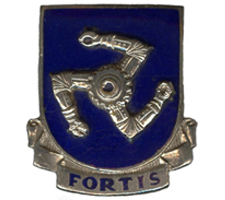
29th Tank
Battalion Distinctive Insignia (Germany, 1950's, Poellath)
The insignia experts Sawicki and
Capistrano both independently state that the 1950's 29th Tank
Battalion, which was very
indirectly descended from the 752nd, used a somewhat different DUI
design than the 752nd. The 29th design featured a more rounded
bottom, a closed scroll, and a wider field around the fisted arms. The change in design was likely a "tweak" to
provide a slightly unique identity for the 29th, while still reflecting
its "paper" lineage to the 752nd.
The
DUI depicted here was produced by the German company Poellath in the
early 50's, which makes sense given that the 29th was stationed in
Germany during that time frame. There are claims of Italian manufacturers
producing the rounded bottom DUI in the postwar period, but to date there is no
evidence of the rounded design ever being worn by a 752nd tanker.
In contrast, the few DUI photos that have surfaced
from the 29th Tank Battalion in Germany do in fact show this
more rounded design, and not the more pointed design that was worn by
the 752nd. The more rounded design also appears on a cigarette lighter inscribed with the 29th Tank Bn name, and also on a pocket patch that was sourced from a 29th Tank Bn vet. From the webmaster's collection.
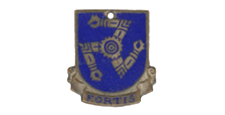
29th Tank
Battalion Sweetheart Bracelet Charm (Germany, 1950's)
A rare 29th Tank
Battalion sweetheart
bracelet charm, shown in correct proportion to
the DUI's above. Note the fastening hole at the top. This particular
sweetheart charm was
crudely turned into a pin by someone who glued a common
carpet tack to the back, and
attached a clutchback fastener to the tack. From the webmaster's collection.
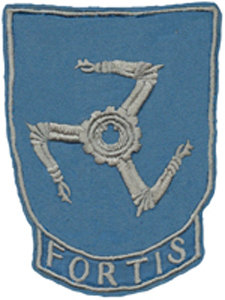
29th Tank
Battalion Pocket Patch (Germany, 1950's)
Patterned
after the 29th Tank Battalion Distinctive Insignia (shown above), this
patch was
quite a bit larger than a typical military shoulder insignia. This was considered a "pocket patch"
or
"souvenir patch" and was not worn on the shoulder of the uniform.
Instead, it was
designed to be worn by returning vets on the front pocket of the field
jacket,
or it was used for decorative purposes (such as photo album covers,
medal
displays, etc.). The patch was machine embroidered on sky-blue thin
cotton cloth.
It is not known when this patch first appeared, or how widespread its
use
was. There
are a number of modern reproduction pocket patches readily
available for sale everyday on eBay from various sellers, but their
design, size, and construction are very different from the authentic
patch shown here and they are made strictly for modern enthusiasts. From the webmaster's collection.
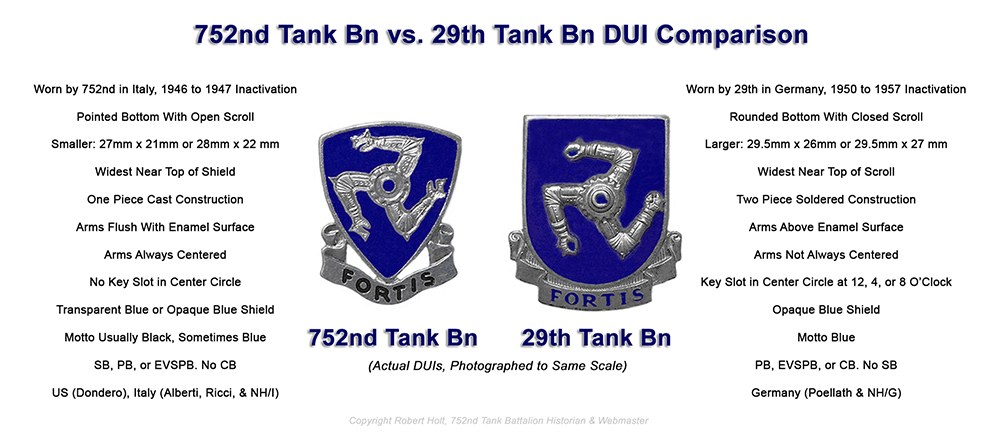
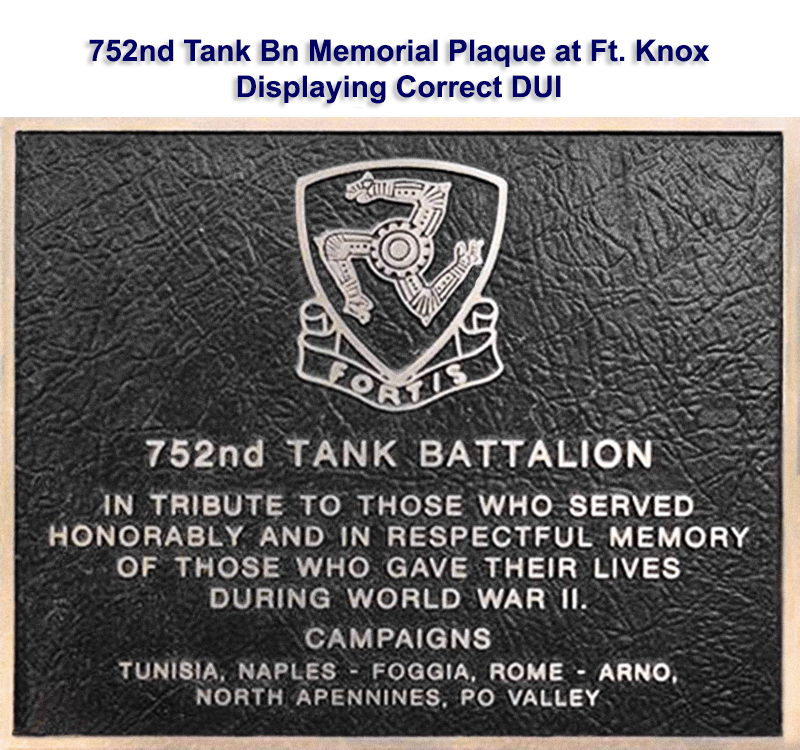
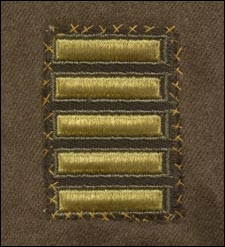 |
Overseas
Service Bars U.S. Army personnel who served overseas were entitled to wear Overseas Service Bars. Each bar represented a full 6 months of service outside of the U.S. The original members of the 752nd who initially shipped out to England were entitled to wear 5 service bars for service through the end of the war. Few, if any, of the original cadre stayed long enough after the end of the war to earn a 6th bar. The bars were sewn on the left sleeve, a few inches above the jacket cuff. These 5 overseas bars were cross-stitched onto an "Ike" jacket belonging to Sgt. Raymond Holt of B Company. From the webmaster's collection. |
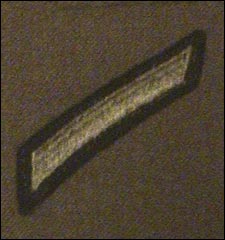 |
Service Stripes Army enlisted men were entitled to wear a Service Stripe, also known as a hash mark, to denote each 3-year period of active service. Service stripes were worn below the overseas stripes, just above the jacket cuff. The service stripe was wider than the overseas bars, and was more subdued in color. Interestingly, very few photos of 752nd tankers show service stripes being worn, even though many of the original men had earned them as early as mid-1944. The majority of men in postwar service with the 752nd had not accumulated enough time to earn a stripe prior to the 752nd's inactivation. From the webmaster's collection. |
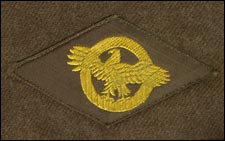 |
Ruptured Duck Honorably discharged servicemen were issued the "Ruptured Duck" insignia to signify to MPs that the soldier was recently discharged. Soldiers were allowed to continue wearing their uniforms for 30 days after discharge, due to the clothing shortage. The original Ruptured Duck was a cloth insignia that was machine-sewn above the right breast pocket by the processing unit. The one depicted was issued in early 1945. The Ruptured Duck was later issued as a pin. From the webmaster's colelction. |
 |
Garrison Cap
Piping - Armored The Armored Corps distinguished itself from other branches through the use of green and white piping on its garrison caps (also known as overseas caps). Green is recognized as the traditional color of the armored corps. Tankers wore their garrison caps with a sharp slant downward toward the left eye (as shown in the B&W photo above). Some postwar tankers, as shown in the photo above, sewed a small tanker's patch onto their garrison cap. From the webmaster's collection. |
Researched
and Written by Robert J. Holt
Page Content Copyright 2004 - 2025 Robert J. Holt
All Rights Reserved